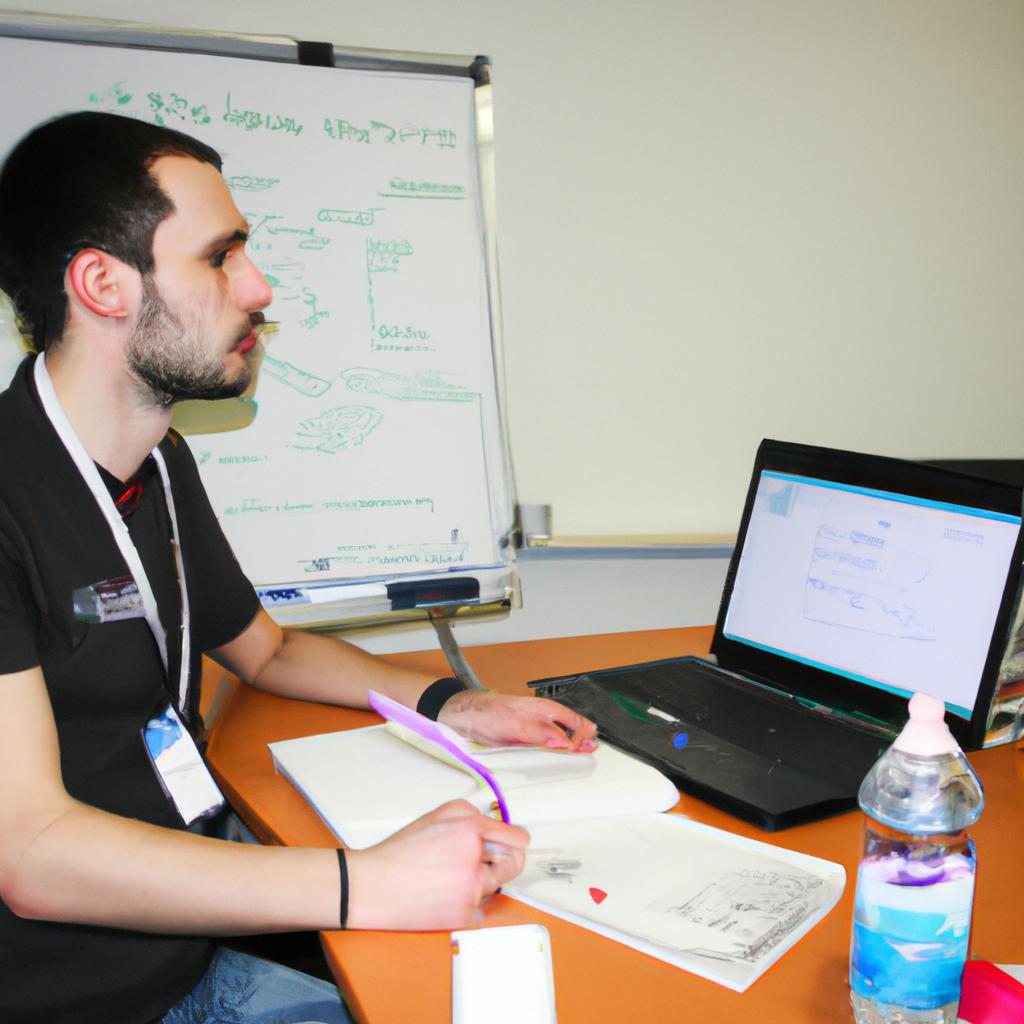Community development finance is a critical aspect of social finance, particularly in the field of science social sciences. This article aims to explore and analyze the role of community development finance in promoting social well-being and sustainable development within scientific communities. By examining real-life case studies and hypothetical scenarios, this study seeks to shed light on the potential impact that effective community development financing can have on addressing socio-economic disparities and fostering positive change.
One example that illustrates the significance of community development finance is found in an urban neighborhood struggling with high levels of unemployment and poverty. Through targeted investments in education and skills training programs, as well as access to affordable housing initiatives, the community was able to improve socioeconomic conditions for its residents. These efforts not only enhanced individual opportunities but also contributed to building a stronger and more resilient community overall.
In order to fully comprehend the complexities associated with community development finance in the context of science social sciences, it is important to examine various dimensions such as financial mechanisms, policy frameworks, stakeholder engagement strategies, and evaluation methodologies. By delving into these aspects, this article aims to provide valuable insights into how different actors can collaborate effectively towards achieving inclusive growth and sustainable development within scientific communities.
Understanding Community Development Finance
Community development finance plays a crucial role in supporting and promoting economic growth, social progress, and environmental sustainability within communities. It refers to the financial mechanisms and strategies that aim to improve the well-being of individuals and communities by providing access to capital, resources, and opportunities. This section will explore the key concepts and components of community development finance.
To illustrate the significance of community development finance, let us consider a hypothetical case study. Imagine a low-income neighborhood struggling with high unemployment rates and limited access to affordable housing. Through community development finance initiatives, this neighborhood can receive funding for small business loans, job training programs, and affordable housing projects. These investments not only stimulate local economic activity but also empower residents to become self-reliant and contribute positively to their community’s growth.
One important aspect of community development finance is its ability to address systemic issues faced by marginalized populations. A bullet point list highlighting some benefits includes:
- Increased employment opportunities
- Enhanced educational facilities
- Improved infrastructure
- Strengthened social cohesion
Furthermore, effective implementation of community development finance requires collaboration among various stakeholders such as government agencies, nonprofit organizations, financial institutions, and community members themselves. A table demonstrating these key players’ roles can be seen below:
| Stakeholder | Role |
|---|---|
| Government | Policy formulation |
| Nonprofits | Project implementation |
| Financial | Capital provision |
| Institutions | Technical assistance |
| Community | Input on needs and priorities |
By involving all relevant actors in decision-making processes, community development finance ensures comprehensive planning and sustainable outcomes that meet the diverse needs of communities.
In summary, understanding community development finance is essential for addressing socioeconomic disparities and fostering inclusive growth within communities. By leveraging financial tools strategically, it becomes possible to create positive change at both individual and collective levels. Transitioning into the subsequent section about “The Role of Finance in Community Development,” we will now explore how finance acts as a catalyst for community empowerment and sustainable development.
The Role of Finance in Community Development
Understanding the importance of community development finance is crucial for realizing the potential impact it can have on society. In this section, we will delve deeper into the role of social finance in science and social sciences, exploring its significance and how it contributes to community development.
One real-life example that highlights the power of social finance in community development is the establishment of a microfinance initiative in an underprivileged neighborhood. This initiative provided small loans to local entrepreneurs who lacked access to traditional banking services. By offering financial support, these individuals were able to start or expand their businesses, creating job opportunities and fostering economic growth within their communities. This case study demonstrates how community development finance can address systemic inequalities by empowering marginalized groups through financial inclusion.
Social finance plays a pivotal role in driving positive change in various ways within scientific and social science disciplines. Here are some key contributions:
- Funding Research: Social finance can provide much-needed funding for research projects focused on addressing societal issues such as poverty alleviation, environmental sustainability, and healthcare accessibility.
- Supporting Innovation: It facilitates innovation by providing capital for scientific advancements that aim to improve quality of life or create sustainable solutions.
- Promoting Collaboration: Social finance encourages interdisciplinary collaboration between scientists, researchers, policymakers, and practitioners from different fields, leading to holistic approaches towards community development.
- Enabling Knowledge Sharing: Through conferences, workshops, and networking events funded by social finance initiatives, experts can share knowledge and best practices related to community development across borders.
To further illustrate these contributions visually, consider the following table:
| Contribution | Description |
|---|---|
| Funding Research | Provides financial resources for research projects aimed at addressing societal challenges. |
| Supporting Innovation | Fosters innovative ideas and technologies with potential transformative impacts on societies. |
| Promoting Collaboration | Encourages multidisciplinary cooperation among stakeholders involved in community development. |
| Enabling Knowledge Sharing | Facilitates the exchange of expertise, best practices, and lessons learned in the field. |
In summary, social finance plays a vital role in community development within the science and social sciences domains. It enables funding for research projects, supports innovation, promotes collaboration among diverse stakeholders, and facilitates knowledge sharing. By harnessing these contributions, we can effectively address societal challenges and work towards creating sustainable and inclusive communities.
Transitioning into the subsequent section on “Challenges and Opportunities in Community Development Finance,” we recognize that while social finance offers immense potential for positive change, it is not without its obstacles. Understanding these challenges will help us navigate through them and identify opportunities to enhance the impact of community development finance initiatives.
Challenges and Opportunities in Community Development Finance
The Role of Finance in Community Development has highlighted the significance of financial resources in driving positive change within communities. In this section, we will delve deeper into the challenges and opportunities that arise when utilizing finance for community development purposes.
One example that demonstrates both a challenge and an opportunity is the financing of affordable housing projects in low-income neighborhoods. On one hand, securing adequate funding to develop such projects can be challenging due to limited resources and competing priorities. However, this also presents an opportunity for innovative financing mechanisms, such as impact investing or social impact bonds, which attract private capital by combining financial returns with measurable social outcomes.
When examining the challenges and opportunities faced in community development finance, several key factors come into play:
-
Limited access to traditional sources of capital: Many communities facing economic disadvantages struggle to secure funding from conventional financial institutions due to perceived risks or lack of collateral. This limited access restricts their ability to initiate meaningful development projects.
-
Balancing financial viability with social objectives: Community development initiatives often aim to address pressing social issues while maintaining long-term financial sustainability. Striking a balance between these two objectives requires careful planning and collaboration among stakeholders.
-
Measuring impact and outcomes: Quantifying the success and effectiveness of community development projects is crucial for attracting continued investment. Robust evaluation frameworks and metrics are needed to demonstrate tangible results and ensure accountability.
-
Addressing systemic inequalities: Community development finance should strive towards creating equitable opportunities for all individuals within a community. Recognizing historical injustices and actively working towards dismantling discriminatory practices is essential in achieving sustainable progress.
To further illustrate these challenges and opportunities, consider the following table:
| Challenges | Opportunities |
|---|---|
| Limited access to traditional funding | Innovative financing mechanisms |
| Balancing financial viability | Collaboration among stakeholders |
| Measuring impact and outcomes | Evaluation frameworks |
| Addressing systemic inequalities | Equitable opportunities for all community members |
In conclusion, the realm of community development finance presents a complex landscape with both challenges and opportunities. By addressing limited access to funding, balancing financial viability with social objectives, measuring impact and outcomes, and tackling systemic inequalities, communities can unlock their full potential for sustainable growth. The next section will explore innovative approaches that have emerged in response to these challenges.
Innovative Approaches to Community Development Finance
Transitioning from the challenges and opportunities discussed above, it is important to highlight some innovative approaches that have been developed in response to these complexities. These approaches seek to address the gaps and limitations identified in traditional financing methods.
Innovative Approaches to Community Development Finance
Having explored the challenges and opportunities in community development finance, it is now imperative to delve into innovative approaches that have emerged to address these issues. One such approach is the concept of impact investing, which seeks both financial returns and measurable positive social or environmental impacts. To illustrate this point, let us consider a hypothetical case study involving a non-profit organization focused on providing affordable housing for low-income communities.
Case Study Example:
The non-profit organization mentioned above aims to develop a new housing project that incorporates sustainable building practices while ensuring affordability for its residents. By partnering with impact investors who prioritize both financial viability and positive societal outcomes, the organization secures the necessary funding to construct energy-efficient homes equipped with renewable energy systems. This collaboration not only addresses pressing social needs but also aligns with global efforts towards sustainability.
Innovative approaches in community development finance can be characterized by several key elements:
-
Collaboration: Successful projects often involve partnerships between different stakeholders, including government agencies, nonprofits, private investors, and local communities. Through collaborative efforts, diverse perspectives are integrated into decision-making processes, leading to more comprehensive solutions.
-
Flexibility: Recognizing that each community has unique requirements and resources, innovative approaches emphasize flexibility in financing structures and project design. Tailoring strategies to specific contexts allows for greater customization and increased chances of success.
-
Holistic Impact Assessment: Unlike traditional investment models solely driven by financial metrics, innovative approaches prioritize holistic impact assessment frameworks. These frameworks evaluate both quantitative indicators (e.g., employment rates) as well as qualitative factors (e.g., improved quality of life), enabling a more nuanced understanding of project outcomes.
-
Long-Term Sustainability: Innovative approaches recognize that true community development requires long-term commitment beyond initial investments. They aim to foster self-sufficiency within communities by supporting skills training programs, entrepreneurial initiatives, and capacity-building efforts.
The table below illustrates the potential impact of innovative approaches in community development finance:
| Key Element | Description |
|---|---|
| Collaboration | Strengthens coordination among stakeholders, leading to more effective and inclusive solutions. |
| Flexibility | Enables adaptation to local needs, maximizing the relevance and success of projects. |
| Holistic Impact Assessment | Provides a comprehensive understanding of project outcomes beyond solely financial measures. |
| Long-Term Sustainability | Promotes self-reliance within communities by supporting ongoing development efforts. |
As we have seen, these innovative approaches offer promising avenues for addressing the challenges faced in community development finance. By embracing collaboration, flexibility, holistic impact assessment, and long-term sustainability, stakeholders can work together towards creating lasting positive change for underprivileged communities.
Transition into subsequent section about “Measuring the Impact of Community Development Finance”:
With a clear understanding of innovative approaches in place, our focus now turns to measuring the impact of community development finance initiatives. This crucial step allows us to assess their effectiveness and identify areas for improvement while ensuring accountability and transparency in this field.
Measuring the Impact of Community Development Finance
Innovative Approaches to Community Development Finance have paved the way for new methods of financing social projects in the field of science and social sciences. One such approach is Social Finance, which harnesses capital from private investors to fund initiatives that address community needs while delivering financial returns. This section explores the application of Social Finance in the realm of science and social sciences, highlighting its potential impact on community development.
To illustrate the effectiveness of Social Finance in this context, consider a hypothetical case study involving a research institute focused on climate change mitigation. Traditionally reliant on government funding, the institute decides to explore alternative sources of finance through Social Finance. By issuing Social Impact Bonds (SIBs), they attract socially conscious investors who are interested in supporting scientific initiatives with long-term benefits for society. The funds raised through SIBs enable the institute to expand their research efforts, develop innovative solutions, and disseminate knowledge widely within the scientific community.
The implementation of Social Finance in science and social sciences can yield several key advantages:
- Increased access to capital: By tapping into private investment pools dedicated to societal causes, organizations working in these fields can overcome resource constraints and secure additional funding.
- Alignment of interests: Social Finance provides an avenue for individual or institutional investors passionate about scientific advancements or societal progress to directly support projects aligned with their values.
- Financial sustainability: Through structured repayment models based on predefined outcomes, organizations funded by Social Impact Bonds are incentivized to achieve measurable success while ensuring financial viability.
- Collaboration opportunities: The involvement of private investors brings diverse perspectives and expertise into the collaborative process between researchers, practitioners, and communities.
These advantages highlight how integrating Social Finance into community development finance strategies can foster innovation and create positive impacts within the realms of science and social sciences. To better understand its potential applications across different sectors and domains, it is crucial to examine various metrics assessing the impact of Community Development Finance as a whole.
[Table]By exploring these metrics, we can gain insights into the effectiveness of Social Finance in achieving desired outcomes and addressing community needs. Furthermore, analyzing case studies from different disciplines within science and social sciences will provide valuable lessons for future practitioners.
As we look ahead to Future Trends in Community Development Finance, it becomes evident that innovative approaches like Social Finance are likely to continue evolving and expanding their reach. The integration of technology, such as blockchain-based financing models or crowdfunding platforms dedicated to scientific research, may further democratize access to capital while enhancing transparency and accountability. By embracing these trends, community development finance can fully embrace its potential as a catalyst for positive change across diverse fields and communities alike.
Future Trends in Community Development Finance
Transitioning from the previous section on measuring the impact of community development finance, we now shift our focus to exploring future trends in this field. As society continues to evolve and face new challenges, it is crucial for community development finance to adapt and respond effectively. In this section, we will examine some potential directions that community development finance may take in the coming years.
One example of a future trend in community development finance could be the increased integration of technology and digital platforms into financing models. For instance, imagine a scenario where an online platform connects investors with local community projects seeking funding. This virtual marketplace would allow individuals to browse through various initiatives, learn about their social impacts, and make informed investment decisions. Such technological advancements have the potential to enhance transparency, accessibility, and efficiency within community development finance.
- Increased collaboration between financial institutions and social enterprises.
- Emphasis on sustainability and environmental considerations in project selection.
- Refined evaluation methods to measure both financial returns and social outcomes.
- Enhanced diversity and inclusivity within decision-making processes.
Additionally, let us present a three-column table showcasing different strategies for advancing community development finance:
| Strategy | Description | Potential Impact |
|---|---|---|
| Collaborative | Foster partnerships among stakeholders | Strengthened networks |
| Innovative | Utilize cutting-edge approaches | Scalable solutions |
| Data-driven | Utilize data analytics for informed decision-making | Improved performance measurement |
As we navigate towards an uncertain future, it is critical for practitioners of community development finance to remain adaptable and forward-thinking. By embracing emerging technologies, fostering collaborations, incorporating sustainable practices, refining evaluation methodologies, promoting diversity and inclusivity within decision-making processes – these are just some possible avenues through which this field can continue making meaningful contributions towards societal well-being.
In conclusion, the future of community development finance holds promise for innovative approaches and collaborative efforts that can address complex social challenges. By harnessing technology, adopting sustainable practices, refining evaluation methods, and promoting inclusivity, we can pave the way for a more equitable and prosperous society.
 Wankanyakla Self Help Group
Wankanyakla Self Help Group



